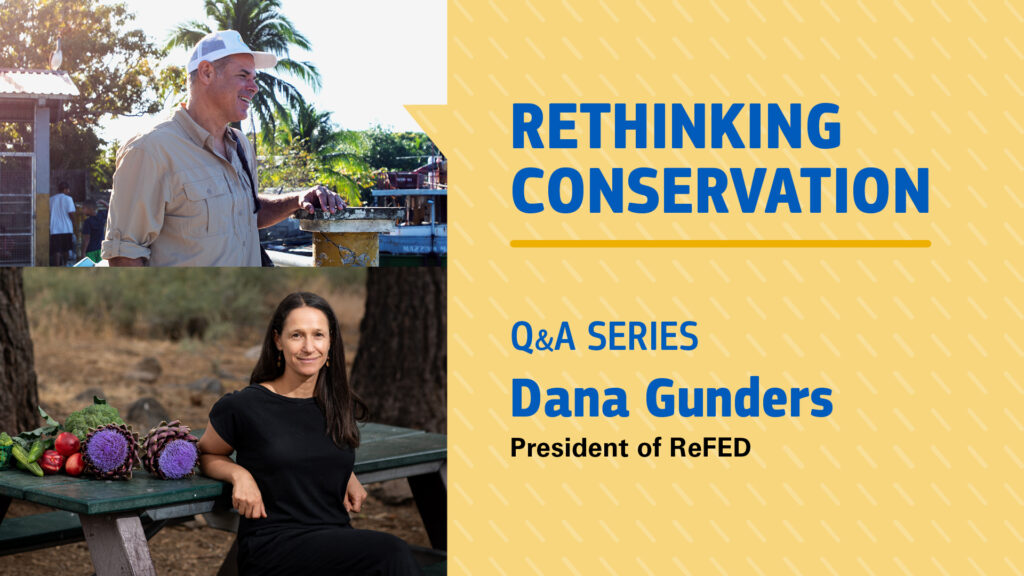
Caleb: Food waste is one of the biggest environmental problems we can actually solve. At Rare, we focus on applying behavioral insights to tackle conservation challenges. Why do you think food waste persists, even when people know it’s a problem?
Dana: In 2023, the U.S. let a third of the 237 million tons of our food supply go unsold or uneaten, what we at ReFED call “surplus food.” That’s almost 120 billion meals, roughly 1.4% of U.S. GDP. Most of this surplus isn’t donated or recycled; it ends up in landfills and other waste destinations. While surplus food occurs across the food system, nearly half comes from consumers like you and me in our homes and restaurants.
People may be aware of the food waste problem broadly, but research suggests they often underestimate their contribution. A 2015 national survey found that while awareness was widespread, three-quarters of respondents believed they discarded less food than the average American. More recently, a 2023 MITRE and Gallup study found that only 33% of people realize how much they spend on food they don’t eat. Therefore, raising consumers’ awareness about just how much food they actually waste — worth nearly $800 per person — and how to manage it more effectively could significantly reduce consumer food waste.
Caleb: Our work in fisheries and sustainable food systems shows that programs that apply behavioral insights can shift behavior. What behavioral interventions have been most successful in reducing food waste?
Dana: Simple behavior changes can make a big difference. ReFED identifies consumer behavior change campaigns as the most cost-effective food waste solution we’ve modeled — creating a net financial benefit of $9 billion and potentially diverting nearly 1.8 million tons of food waste every year. Individual actions can help solve this challenge today.
U.S. consumers waste nearly 35 million tons of food every year, over 200 pounds per person. This is largely due to habits and behaviors like poor food management or over-ordering at restaurants. Confusion over food date labels also contributes — many people think these dates tell them the food is bad when in fact it’s still fine to eat.
You would think that persuading people to change their behavior wouldn’t be that hard, especially since they want to save money. But the challenge is that once food is thrown out, it’s too late. We need people to think about managing food before it goes bad — planning ahead to avoid over-buying food, using freezers, understanding date labels, and using senses to assess food safety. Innovative solutions like buying upcycled products (made with food that would otherwise go to waste) or “ugly” produce also help. Composting food scraps is another great option, as it recycles nutrients, improves soils, and reduces greenhouse gas emissions.
Caleb: Behavioral barriers often hinder sustainable choices. What’s the biggest psychological or cultural obstacle to reducing food waste, and how is ReFED working to overcome it?
Dana: Wasting food isn’t really taboo. Throwing food on the sidewalk is frowned upon, but throwing it in the trash isn’t. Americans have a proclivity for abundance — tables overflowing with food on holidays, ‘buy one, get one’ deals, and oversized portions at restaurants. This leads to food waste throughout the supply chain. We expect grocery store shelves to be full and have a bevy of choices in the cafeteria, but that expectation leads to overstocking, overproduction, and ultimately wasted food.
ReFED educates the public about the scale of food waste and actions to combat it. We emphasize that when food is wasted, so are the natural resources used to produce it. If all U.S. surplus food were grown in one place, this “mega farm” would cover an area the size of California and New York combined and use enough water for every American to shower seven times a day all year.
We advocate for personal choices in food purchasing, storage, consumption, and habits. Our goal is to shift the food system from acting on instinct to acting on insight. ReFED exists to connect the dots and advance proven solutions to reduce food waste in America.
Caleb: Our work suggests that changing defaults, like making sustainable choices easier, can be more effective than persuasion. What’s an example where shifting a default can significantly cut food waste?
Dana: Date label confusion is a prime example. ReFED estimates that nearly 1.5 million tons of food are discarded in homes because of inconsistent and confusing date labels like “best by,” “sell by,” “use by,” and “expires on.” A 2025 Harris Poll found that consumer confusion around food date labels has grown, with 43% of U.S. adults reporting they “always or usually” discard food near or past the date on the label, and 44% mistakenly believe that the federal government regulates labels.
We also estimate that standardizing date labels can divert 425,000 tons of food from waste annually, creating $1.82 billion in net financial benefit. In 2024, California passed a game-changing law to standardize food date labels by 2026. While federal legislation has stalled, we’re hopeful that new federal legislation will be introduced in this Congress.
In the absence of policy, consumers can use their senses to determine if food is safe to eat. If a product looks, smells, and tastes good, and has a “best by” or “best if used by” label, it’s probably OK to consume.
Caleb: Collaborations like our TEDx Countdown event, focusing on consumer perspectives in food waste reduction, highlight the importance of partnerships. How can organizations better collaborate to make food waste reduction strategies part of people’s daily lives?
Dana: Collaboration is key. By partnering, we can pool resources, share insights, and amplify our impact. Engaging consumers through relatable narratives, accessible tools, and community-based initiatives can integrate food waste reduction into daily routines. It’s about making sustainable choices the default, not the exception.